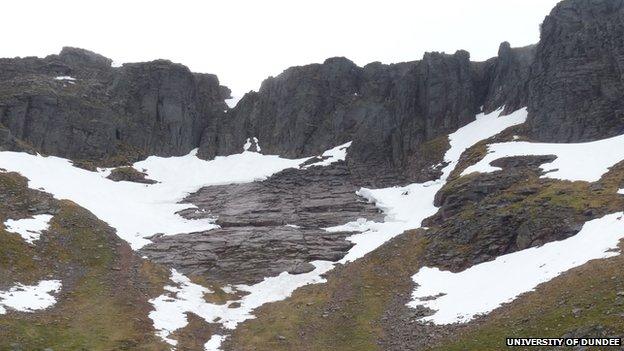Scotland had a glacier up to 1700s, say scientists
- Published

The new research suggests glaciers survived in the Cairngorms long after they were thought to have melted
A glacier was still in place in Scotland within the past 400 years - 11,000 years later than previously thought - it has been suggested.
Dundee University geographer Dr Martin Kirkbride said a glacier may have survived in the Cairngorms as recently as the 18th Century.
Britain's last masses of slow-moving ice and snow were understood to have melted 11,500 years ago.
Dr Kirkbride studied the formation of corries in the Cairngorms.
A corrie is a basin-shaped feature created by glaciations in the mountains.
Using a technique called cosmogenic 10Be dating, Dr Kirkbride showed that a small glacier in a Cairngorms corrie piled up granite boulders to form moraine ridges within the past few centuries, during the period of cool climate known as the Little Ice Age.
Dr Kirkbride said: "Our laboratory dating indicates that the moraines were formed within the last couple of thousand years, which shows that a Scottish glacier existed more recently than we had previously thought.
"The climate of the last few millennia was at its most severe between 1650 and 1790.
"There are some anecdotal reports from that time of snow covering some of the mountain tops year-round. What we have now is the scientific evidence that there was indeed a glacier."
Dundee University said scientists had speculated that glaciers may have re-formed in the Highlands around the time of this Little Ice Age but hard evidence has proved to be elusive.
Dr Kirkbride teamed up with Dr Jez Everest at the British Geological Survey in Edinburgh, and the Cosmogenic Isotope Analysis Facility at the Scottish Universities Environmental Reactor Centre in East Kilbride, to carry out the research.
Dr Everest said: "This is exciting news, as for the first time we have shown that climatic conditions in Scotland allowed glaciation within the last half millennium, at a time when other glaciated areas, such as Scandinavia, Iceland and the Alps saw their glaciers grow to some of their largest sizes since the end of the last Ice Age.
"This has great importance when we start to reconstruct climate change in Scotland and the wider region over the last few centuries."
The dating technique used estimates the time since quartz crystals in granite boulders were exposed at the Earth's surface, based on measuring the concentration of beryllium-10 isotopes which form when the rock surface is bombarded by cosmic rays from deep space.
Dr Kirkbride's discovery is backed up by a parallel study by Dr Stephan Harrison, of the University of Exeter, and Dr Anne Rowan, of the University of Aberystwyth.
They have developed a model to simulate Little Ice Age climate in the Cairngorms, allowing them to calculate how much cooler and snowier the winter weather must have been to cause glaciers to form.
The models show that small glaciers would have been created in the corries by a cooling of air temperatures by 1.5C and precipitation increasing by 10%.
Dr Harrison said: "Our findings show that the Cairngorm mountains were probably home to a number of small glaciers during the last few hundred years - around 11,000 years later than previous evidence has suggested.
"It may be that such glaciers also existed in the Scottish Highlands and elsewhere during other cold periods after the main ice sheets had disappeared."
He added: "Present climate warming means there is little chance of a return of glacier ice to the Highlands for the foreseeable future."
Both studies are published in the latest issue of the journal The Holocene.
- Published21 January 2014
- Published16 April 2013
- Published20 August 2010